Located in Isehara City, Kanagawa Prefecture, the Oyama Afuri Shrine is a historic shrine that sits halfway up Mt.
(There is also an article about its history, which you are encouraged to read!)
Easy access from central Tokyo and surrounded by abundant nature and a sacred atmosphere, this is the perfect place to refresh your body and soul. In this article, I would like to share with you the charm of this place through my experience of visiting Oyama for two days and one night.
First, let’s prepare!
Oyama is an easily accessible location from Tokyo, but if you go there by public transportation, there are no supermarkets or convenience stores close by like there are in central Tokyo. (If you are going by car, you will be fine!)
So, please be properly prepared and head there!
1. Clothing
Clothing
Basically, the temperature is about the same as in Tokyo. However, the weather in the mountains is changeable. It is a good idea to bring rain gear and an extra layer of clothing.
Shoes
Oyama is a very hilly area. We recommend that you wear comfortable shoes that you are used to walking in.
Hiking
If you wish to hike, you should also bring hiking shoes, a knapsack, and other clothing suitable for mountain climbing. This is not a mountain that can be climbed easily. (In particular, if you want to go to the top, please refer to the mountaineering attire.)
2、Prepare to stay overnight
There are many lodgings in Oyama. Shukubo are shrines and temples where visitors and ascetic practitioners can stay overnight. Some of them are a little different from ordinary business hotels, so be prepared to enjoy your stay there as well.
Amenities
The minimum amenities are provided. Soaps, toothbrushes, yukata (Japanese bathrobe), and towels are usually included in the room set, although it varies from inn to inn.
If you need a comb, beauty products, or your favorite soap, please bring your own.
Pajamas
Most hotels provide yukata (Japanese bathrobes). If you are not used to wearing one, or if it is winter, you may want to bring your own pajamas.
3. Others
As mentioned above, this is a very hilly area. Although you may have an itinerary before and after the trip, it would be a good idea to dress lightly if possible.
Also, most places accept cards and QR payments, but there are some stores that only accept money orders or cash. It is a good idea to have some cash with you.
Now that you have an idea of what to expect, let’s get going!
Then, let’s go!
Day 1: Close to Tokyo! To Oyama
Morning: From Isehara Station to Oyama
To get to Oyama from Tokyo by public transportation, take the Odakyu Line from Shinjuku Station. It takes about 60 minutes to Isehara Station by rapid train. It is very convenient because you can get there in one train without changing trains! After arriving at Isehara Station, transfer to a bus bound for Oyama Cable Station, and after a 30-minute ride, you will arrive at the foot of lush green Oyama. The bus terminates right in the middle of the city.
Lunch
First, let’s get hungry. For lunch, we will have the Oyama specialty, tofu! At various restaurants, you can enjoy tofu courses such as fluffy yudofu, rich tofu dengaku, tofu cutlets, and more. (Served in a course style, it is called a tofu kaiseki.)
Many of the restaurants are located along the approach to the temple, where originally inns were operated and are now open for business as restaurants. It is fun to stroll around while looking for your favorite place. This time, I ordered a five-course meal at one restaurant. The creative tofu dishes came out one after another, and I was so full that I could not eat them all!
I especially loved the soy milk hot pot!
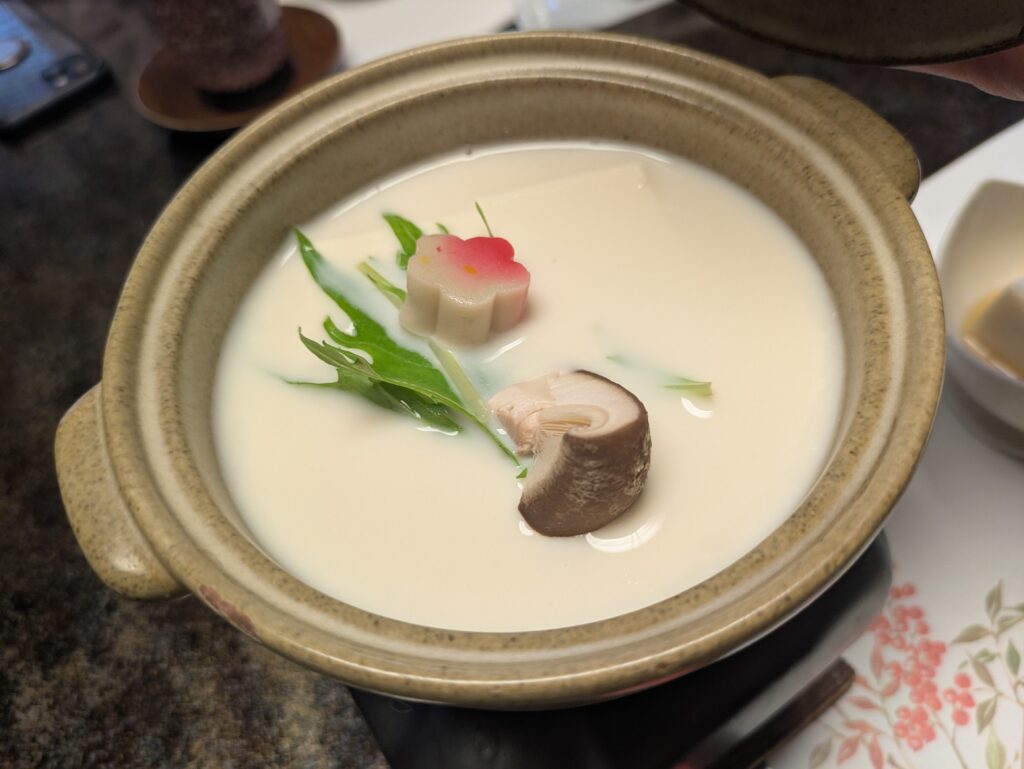
Afternoon: Stroll in the town of Oyama
We will visit the shrine tomorrow and take a walk around the town today. The town of Oyama has prospered along the approach to the shrine. Since cars have become more common, there are now two main routes, the old road and the new road, that run parallel to each other.
The new route along the bus route has many stores such as Oyama Manju and tofu shops as well as lodging houses. This time I bought some Oyama manju for a snack. I was told that this is a popular sweet that is sometimes sold out after noon. It was a thin-skinned manju and was warm and delicious.
The old road is very narrow, and it would be difficult to drive on it by car, but it is a very quaint street. There are several waterfalls that are still used to purify oneself. Just walking along the path was like stepping back in time.
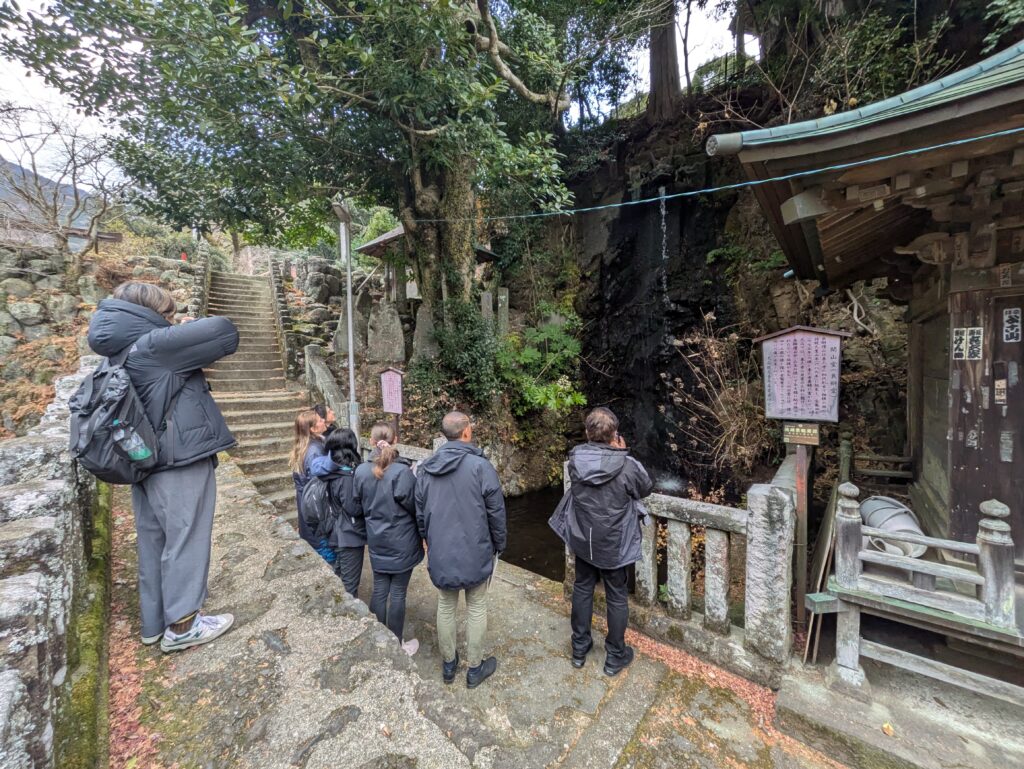
Night: Stay overnight at a shukubo (lodging house)
One of the attractions of this area is the shukubo experience. Since we went all this way, we checked in around 4:00 p.m. and spent the rest of the night at an inn. The Japanese atmosphere from the entrance is very exciting. The room we were shown was a spacious Japanese-style room. The futon was already set up, and in the calm atmosphere of the Japanese-style room, I was able to forget the hustle and bustle of daily life and spend my time in peace and quiet.
Dinner started at 18:00. Like lunch, a lot of tofu was used, but sashimi and meat were also used, which was very tasty. The dishes are also beautiful, and we hope you enjoy their appearance as well! After dinner, the owner of the inn told us a interesting story about the history of Mt. Oyama and the history of the inn. It was a very special experience.
It was the first time I had ever heard such a story, and I enjoyed it so much that we talked for an hour!
Day 2: Shrine visit
Morning: Morning prayers in the fresh air 6:30 a.m. I awoke to the beautiful light of the morning sun. After a brief dressing up, we have a morning purification ceremony at the shrine of the inn where we stayed. Morning worship in the clear morning air is exceptional. In the sacred atmosphere, when you quietly put your hands together, it feels like your heart is cleansed.
Morning: Shrine visit
After a delicious breakfast and getting ready for the day, we will finally visit the Oyama Afuri Shrine.-
This time, we will use the cable car to visit the shrine.
After a 20-30 minute walk up the approach from the inn, you will arrive at the cable car station.
After buying a ticket, we boarded the cable car for a 6-minute ride. The scenery that gradually comes into view makes your heart dance.
After getting off the cable car, we climbed the last stairs to shrine. There are more steps than expected, but the goal is right in front of you, so your steps are light.
At the top of the stairs, you will see a magnificent shrine in front of you! And when you look back, there is a spectacular view! There is so much to see both in front and behind that I scurried around for a while.
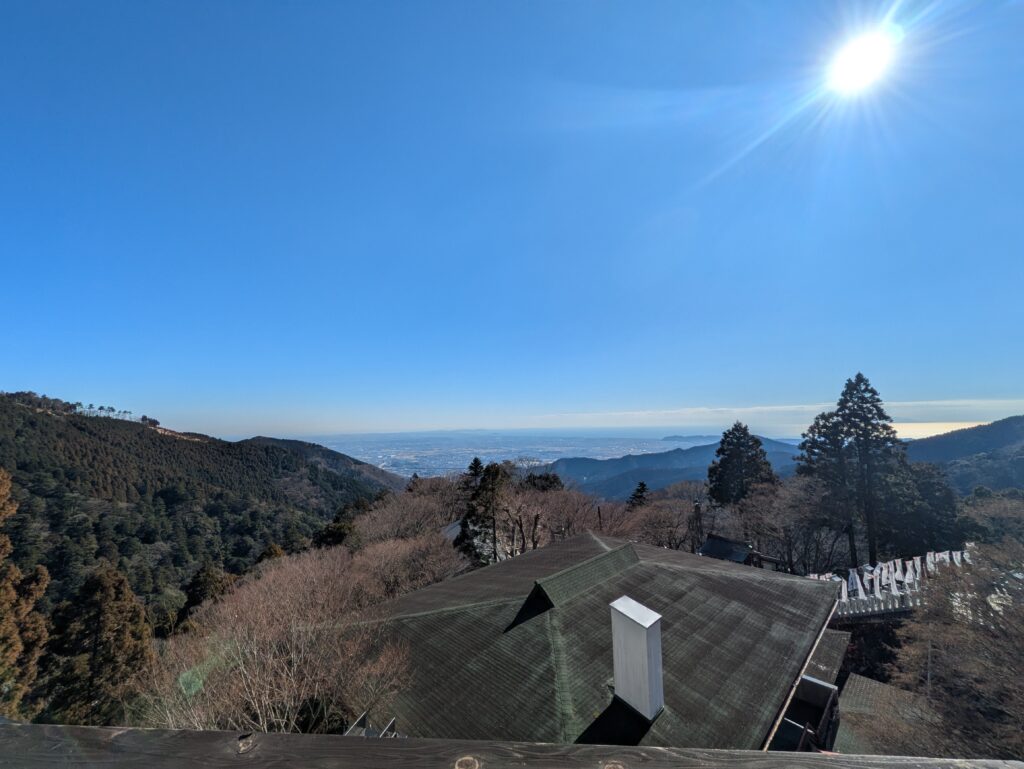

It would be fine to just visit the shrine from the outside, but since it was a special opportunity, I decided to go inside to pray. Inside the shrine, in the sacred atmosphere, In this sacred atmosphere, prayers are offered and and offer a tamagushi.
It was my first time to do this, but I managed to do it well despite my nervousness as they showed me how to do it.
Facing the front of the shrine, there is a small path on the right. At the back of the path, there is a spot where you can get “Shinsen,” the famous water of Mt.Oyama. Even if you don’t have a water bottle, there are empty plastic bottles for sale so you can take the water home with you. We took the opportunity to get some!
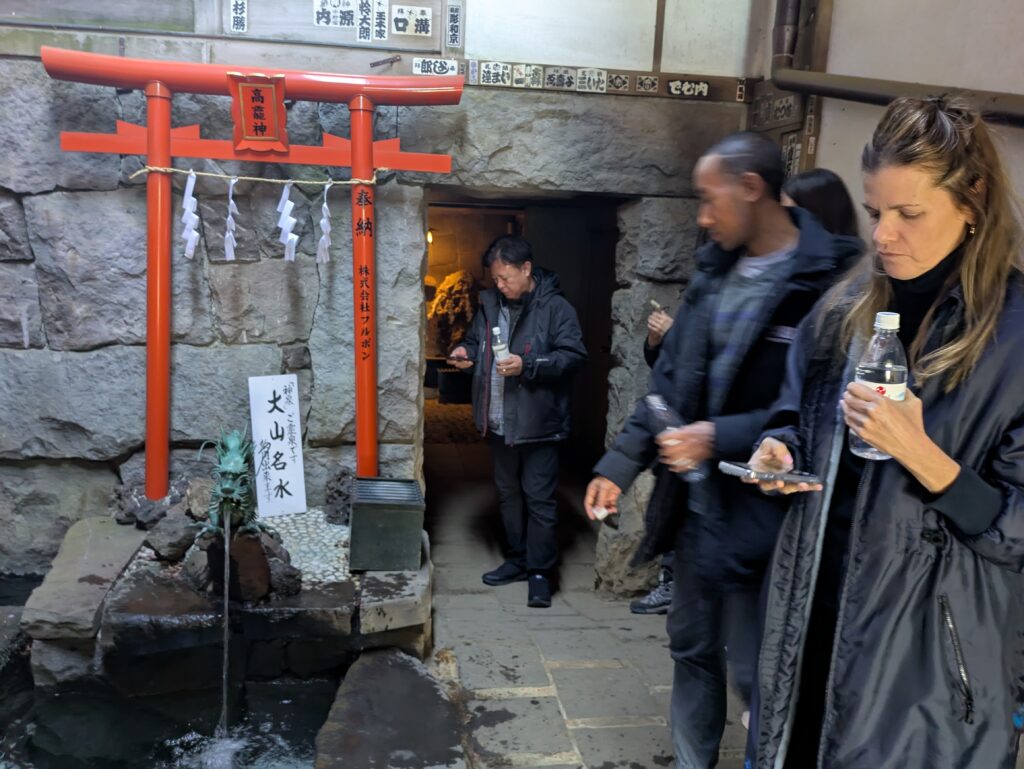
Afternoon: Hiking down the mountain
Since the weather was fine, we decided to go back on foot. We enjoyed a 90-minute hike, stopping at Oyama-dera Temple along the way. Oyama-dera Temple is a historic temple built in the Nara period (710-794) and is famous as “Oyama Fudo. A powerful statue of Fudo Myoo is enshrined in the main hall, and the temple is crowded with worshippers praying for good luck and protection from bad luck. It is also a popular spot famous for its autumn foliage!
Afternoon: Stroll along Koma-sando and look for souvenirs
Toward the end of the tour, we will go to “Koma-sando” to look for souvenirs. Koma-sando is a street with a long history dating back to the Edo period (1603-1868), when pilgrimages to Mt.Oyama. Especially, Oyama koma (spinning-top), carefully made by craftsmen, has been loved as a good-luck talisman for family safety and business prosperity. Cafes and souvenir shops still line the traditional approach to the shrine, reminding visitors of its history and traditions.
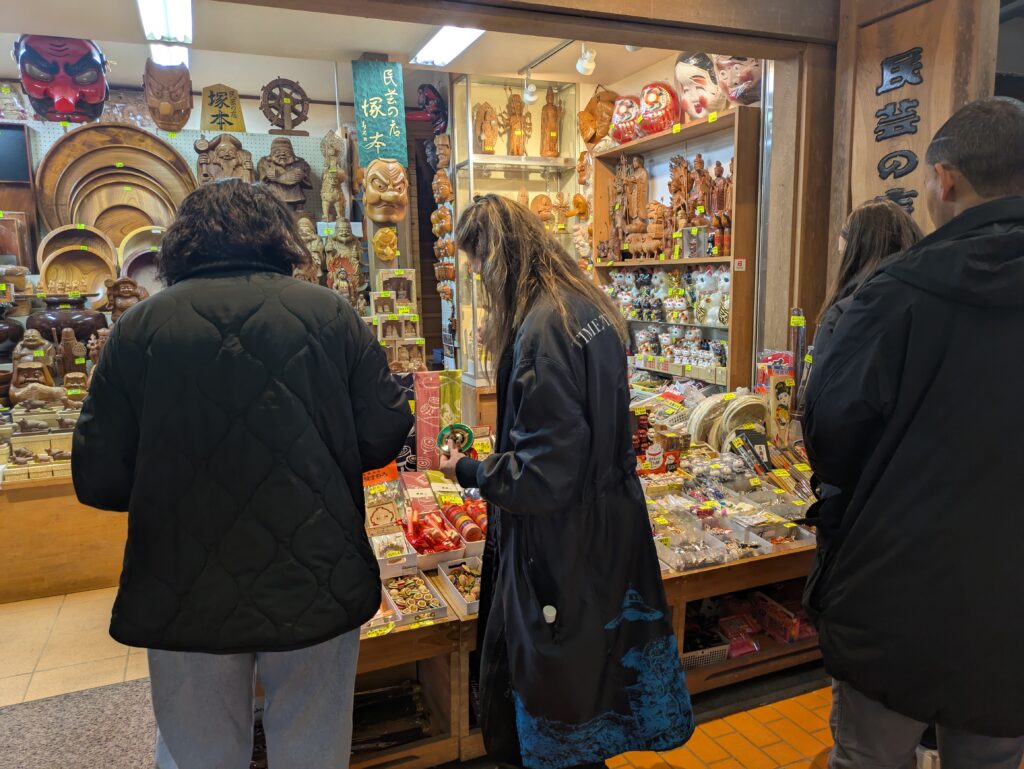
A Journey of Healing for Body and Soul
A two-day and one-night trip to the Oyama Afuri Shrine area was a restful time that allowed me to forget the hustle and bustle of the city. The abundant nature, delicious local specialties, and the austere atmosphere of the historic shrine made for a trip that refreshed both body and soul.
